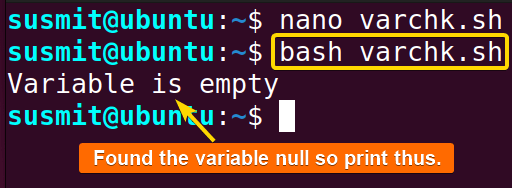FUNDAMENTALS A Complete Guide for Beginners

Programmers work with several variables in the Bash scripts. So verifying whether a variable is empty or not is a crucial task in Bash scripting. By ensuring the emptiness of variables, programmers can handle different scenarios and enhance the reliability of their scripts. This article explores various techniques and commands for checking if a Bash variable is empty or not. So, gain the skills to write robust and error-resistant code.
Key Takeaways
- Getting familiar with the process of checking whether a bash variable is empty using the -n flag and double bracket.
- Knowing about the usage of the double bracket to check whether a Bash variable is empty.
Free Downloads
2 Methods to Check Whether Bash Variable is Empty
Checking whether a Bash variable is empty or not is a crucial task for any programmer. Here, I will show you two methods of checking if the Bash variable is empty.
Method 01: Using Flag “-n” to Check Bash Variable Whether It is Empty
Checking a Bash variable whether it is empty or not, is a crucial task. Here, I have developed a Bash script that can perform the task with if condition and. To do so, follow the below procedures.
❶ At first, launch an Ubuntu Terminal.
❷ Write the following command to open a file in Nano:
nano varchk.sh- nano: Opens and creates a file in the nano text editor.
- varchk.sh: File name.
❸ Copy the script mentioned below:
#!/bin/bash
var="" #NULL is set as the value of var variable
if [ -n "$var" ]; then
echo "Variable is $var" #check the value of var variable if found, then print this line with the value of var on the terminal
else
echo "Variable is empty" #if the value of var is not found means it is empty, then prints this line on the terminal
fi#! /bin/bash ‘#!’, is called shebang or hashbang. It indicates the interpreter to be used for executing the script, in this case, it’s bash. Then var=”” command set NULL as the value of the var variable. Then, if [ -n “$var” ]; then echo “Variable is $var” command checks the value of the var variable if found then print this line with the value of var on the terminal. If the variable is empty then the else echo “Variable is empty” command prints this line on the terminal.
❹ Press CTRL+O and ENTER to save the file; CTRL+X to exit.
➎ Run the script by the following command:
bash varchk.sh- bash: Executes the bash scripts.
- varchk.sh: Bash script name.

Method 02: Using Double Brackets to Check if a Bash Variable is Empty
In this section, I will develop a Bash script using double brackets to check if a Bash variable is empty. To know about the process, follow the below script.
Script (double.sh) >
#!/bin/bash
NAME="" #NAME variable is set
# Define the command to check if the variable is empty
check_empty_command='[[ ! -n "$NAME" ]] && echo "Name is empty"'
# Execute the command using bash -c
bash -c "$check_empty_command"The NAME=”” command set NULL to the NAME variable. Then the check_empty_command variable is defined. Then the bash -c “$check_empty_command” command checks whether the variable is empty if so, prints a message on the terminal.
Run the script by the following command:
bash double.sh
Comparative Analysis of the Methods
In this article, I have shown you two methods of checking whether a Bash variable is empty. Now I will show you a comparative analysis of these two methods.
| Methods | Pros | Cons |
|---|---|---|
| Method 01 |
|
|
| Method 02 |
|
|
If you want to create a Bash script with easy-to-understand commands you can follow method 1. But if you need to create a concise script, you can follow method 2.
Conclusion
In conclusion, checking if a Bash variable is empty is essential in shell scripting. By using a double bracket with the ‘-z’ operator or the ‘-n’ operator, we can easily determine if a variable is empty or not. These techniques provide effective ways to verify empty variables, ensuring robust and accurate scripts. Mastering variables checks allows for better data validation and script reliability. Remember to consider variable expansion and quoting to ensure accurate evaluations. With these methods, you can confidently check empty variables in Bash scripts.
People Also Ask
Related Articles
- How to Echo Variables in Bash Script? [4 Practical Examples]
- How to Use String Variables in Bash Script? [4 Cases]
- How to Append String to Bash Variable? [2 Effective Ways]
- How to Check If Bash Variable Exists? [2 Effective Methods]
- How to List and Set Bash Environment Variables? [3 Methods]
- 2 Ways to Unset Environment Variables Using Bash Script
- 5 Methods to Check If Environment Variable is Set in Bash Script
- How to Set Bash $PATH Variable? [Easiest Configuration]
- 2 Cases to Execute Command Stored in Bash Variable
- How to Store Command Output to Bash Variable? [3 Examples]
- How to Read a File into Bash Variable? [2 Simple Methods]
- How to Write Bash Variable to File? [3 Effective Methods]
- Compare Variables in Bash Scripts [3 Practical Cases]
- Increment Variable Value in Bash Scripts [4+ Examples]
- Adding 1 to Bash Variable [3 Examples]
- Decrement Variable Value in Bash Scripts [4+ Examples]
- Addition of Bash Variable [4+ Examples]
- How to Subtract Two Bash Variables? [4+ Easy Approaches]
- How to Multiply Variable in Bash [6+ Practical Examples]
- Variable Substitution in Bash [Replace Character & Substring]
<< Go Back to Using Variables in Bash Scripting | Bash Variables | Bash Scripting Tutorial



